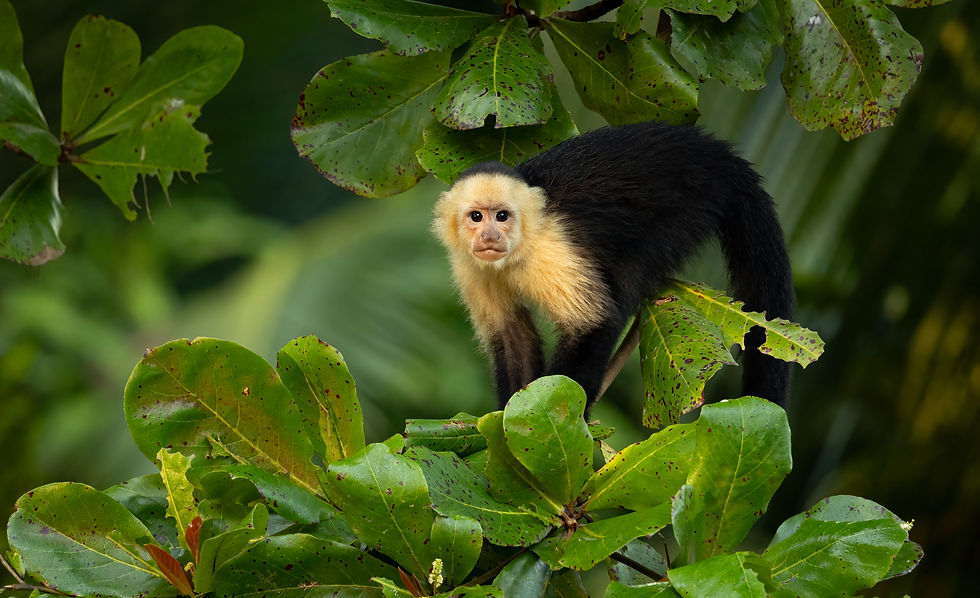The Capuchin Monkeys of Central and South America
- Rico Tico Tours

- Apr 6
- 4 min read

Tucked within the vibrant jungles of Central and South America, a small, expressive primate swings through the canopy with uncanny intelligence and social charm. The capuchin monkey, belonging to the genus Cebus and Sapajus, has earned a reputation not just for its agility but for its remarkable brainpower. Whether deftly cracking nuts with tools or engaging in complex social play, capuchins captivate all who encounter them. Join us as we unravel the world of these clever primates—from their physical traits to their vital role in rainforest ecosystems.
Physical Characteristics: Small in Size, Big in Personality
Capuchin monkeys are medium-sized New World primates, typically measuring 30 to 56 cm (12 to 22 inches) in body length, with prehensile tails that can match or exceed their body length. These tails serve as a vital “extra limb,” allowing them to grip branches securely as they move through the treetops with playful dexterity.
Weighing between 1.3 to 4.8 kg (3 to 10.5 pounds), capuchins have a striking appearance—most notably in the white-faced (or white-headed) species, with creamy fur contrasting against dark limbs and body. Their expressive eyes and highly mobile faces are well-suited for social signaling and have even made them popular in pop culture, though their role in the wild is far more fascinating.
A Mind Like No Other: Tool Use and Intelligence
What truly sets capuchin monkeys apart is their extraordinary intelligence. Among the most intelligent New World monkeys, capuchins have been observed using tools in the wild—a rare behavior in the animal kingdom. From using sticks to extract insects to smashing hard nuts with rocks, their ability to manipulate their environment shows foresight and problem-solving skills typically associated with apes.
In captivity and the wild, they demonstrate long-term memory, planning, and even deception, traits that highlight their advanced cognitive abilities. Their large brains (in proportion to body size) rival that of chimpanzees, making them a subject of ongoing research into animal cognition.
Tours where you can see me
Diet: Omnivores of Opportunity
Capuchins are omnivores with a varied diet that includes fruits, insects, small vertebrates, eggs, nuts, seeds, and even flowers. Their diverse palate not only sustains them but also gives them an essential ecological role as seed dispersers and pest controllers.
They are known to exhibit seasonal food strategies, adjusting their foraging techniques based on the availability of resources. When fruit is scarce, their creativity shines through, as they turn to harder-to-access foods and employ tools to get the job done.
Social Structure: Tight-Knit Troops with Strong Bonds
Capuchin monkeys live in highly social groups ranging from 10 to 30 individuals, often led by a dominant male but structured around strong female kin bonds. These troops exhibit intricate social behaviors including grooming, coalition-building, and cooperative care of young.
Play is a central feature of capuchin society. Youngsters engage in games that teach coordination, social cues, and hierarchy. Adults, too, are often seen engaging in what appears to be playful teasing or gentle sparring—a behavior that underscores their emotional complexity.
Reproduction: Close Bonds and Careful Parenting
Female capuchins typically give birth to a single infant after a gestation period of about 160 days (just over 5 months). The newborn clings to its mother’s back for the first few months, gradually gaining independence as it begins to explore under her watchful eye.
Mothers are primary caregivers, but in some groups, older siblings or even unrelated adults may participate in alloparenting—a form of communal care that strengthens group cohesion. Capuchins reproduce relatively slowly, with interbirth intervals of up to two years, making them especially vulnerable to population pressures.
Habitat: Masters of Adaptation
Capuchin monkeys are highly adaptable and inhabit a wide range of environments—from tropical rainforests and dry forests to mangroves and scrublands. Their range stretches from Honduras and Costa Rica in Central America down into northern Argentina and Brazil in South America.
Their arboreal agility allows them to exploit a variety of ecological niches, but they are also known to descend to the forest floor in search of food. This versatility has helped them survive in fragmented landscapes, though not without challenges.
Conservation Status: Facing Modern Pressures
Despite their adaptability, capuchin monkeys face several human-induced threats:
Habitat Loss: Deforestation for agriculture, logging, and urban sprawl continues to shrink their natural range.
Illegal Wildlife Trade: Their intelligence and “cute” appearance make them a target for the pet trade, often with tragic consequences.
Hunting and Conflict: In some areas, they are hunted or killed as crop pests, despite their ecological benefits.
Some species of capuchin, such as the blond capuchin (Sapajus flavius), are critically endangered, while others are under growing pressure. Conservation initiatives focus on habitat protection, education, and enforcing anti-trafficking laws.
Ecological Role: Forest Gardeners and Seed Dispersers
Capuchins are more than just clever foragers—they are crucial players in the rainforest ecosystem. By dispersing seeds and controlling insect populations, they help maintain plant diversity and forest health. Their foraging behaviors create opportunities for other animals and influence the structure of the habitats they roam.
They also serve as prey for large raptors and felines, occupying an important position in the food web that connects species across the rainforest canopy.
Download our FREE PDF of fun & fascinating facts about capuchin monkeys




